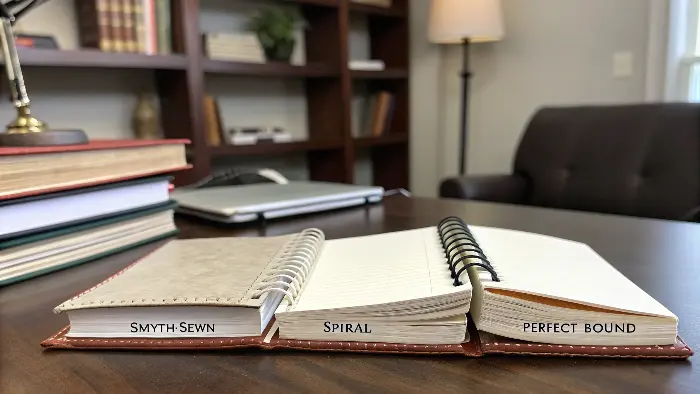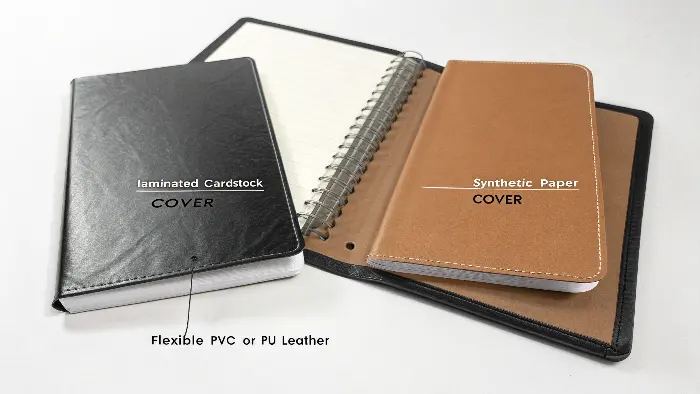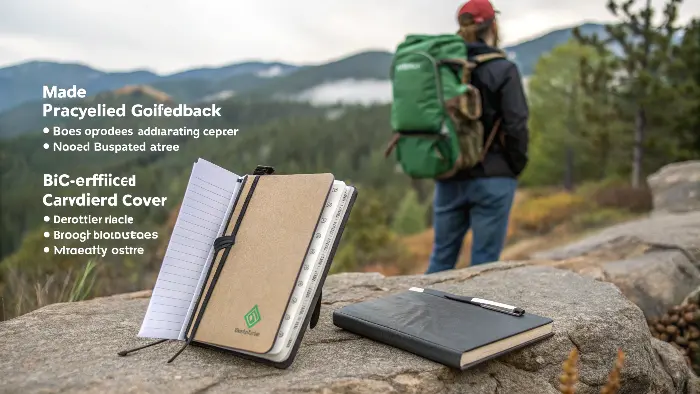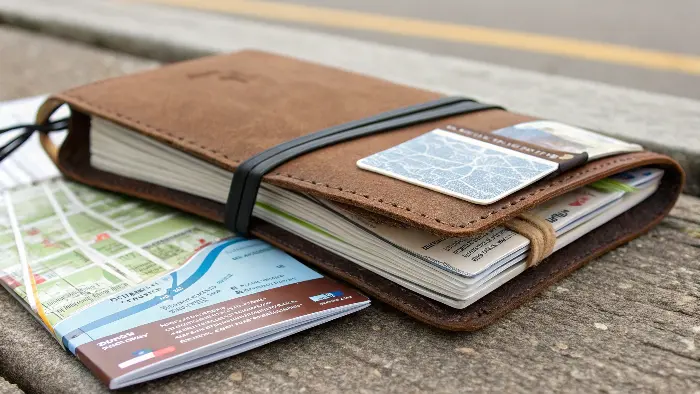Creating a travel guide that falls apart after one trip is a product manager’s nightmare. Customers get frustrated with lost pages and a ruined book, which hurts your brand’s reputation. Choosing the right field-ready binding method ensures your guide survives any adventure and builds customer trust.
For maximum durability in a field-use travel guide, Smyth-sewn binding is the gold standard. It allows the book to lay flat and secures pages firmly. For lay-flat convenience and toughness, a high-quality spiral or wire-o binding is also an excellent choice, especially when paired with a durable, water-resistant cover.

The right choice depends on more than just the binding itself. It’s about understanding how different elements work together to create a truly resilient product. A book that can be shoved into a backpack, opened in the rain, and flipped through hundreds of times requires careful thought from cover to cover. Let’s break down the most popular options to see which one fits your project best.
Which binding is best: Spiral, Sewn, or Perfect Bound for outdoor use?
Choosing a binding method can feel like a gamble. If you pick the wrong one, your beautiful guides end up with broken spines and loose pages, leading to unhappy customers and costly replacements. Understanding the core strengths of each type helps you make a confident, informed decision for your brand.
Smyth-sewn binding offers superior durability and a premium feel, but spiral or wire-o binding provides unmatched lay-flat functionality, which is crucial for field use. Perfect binding is the most common and affordable but is the least durable for rugged conditions, as pages are only held by glue and can detach with rough handling.

When we talk about durability, we’re really talking about how a book holds up to stress. A travel guide faces constant bending, flexing, and page-turning. Here’s how the main binding types perform under that pressure.
The Lay-Flat Champion: Spiral & Wire-O
Spiral and wire-o bindings are fantastic for usability. The ability to fold the book back on itself is a huge advantage when you’re trying to navigate a city street with a map in one hand. The pages turn smoothly and stay put. The main weakness is the potential for pages to tear at the punch-holes, especially if the paper is thin. We always recommend using a heavier paper stock (at least 100 gsm) to prevent this. The wire itself can also get bent out of shape in a tightly packed bag, though high-quality, thick wire minimizes this risk.
The Durability King: Smyth-Sewn
This is the traditional, high-end method for a reason. Pages are grouped into sections (called signatures) and then physically stitched together with thread. This stitched block is then glued to the cover. This process makes it almost impossible for a page to fall out. It also allows the book to open and lay relatively flat without stressing the spine. It’s the most labor-intensive and expensive option, but for a premium travel guide meant to be a long-lasting keepsake, the investment in Smyth-sewn binding pays off in customer satisfaction and brand perception.
The Budget Option: Perfect Binding
This is the method used for most paperback books. The pages are stacked and glued directly to the spine. It’s fast and cost-effective for large runs, but it’s the least durable choice for field use. The glue can become brittle in cold weather or weaken with repeated flexing, causing pages to detach. For a guide that will be heavily used outdoors, I almost always advise clients against standard perfect binding.
How do cover materials enhance the durability of a field guide?
A strong binding is useless if the cover gets soaked and torn on day one. A flimsy cover makes the entire guide feel cheap and unreliable, no matter how well it’s bound. Selecting the right cover material acts as the first line of defense against moisture, dirt, and rough handling.
A durable cover is essential. Laminated cardstock offers good water resistance and stiffness. For superior durability, consider synthetic papers like Yupo or Teslin, which are waterproof and tear-proof. A flexible PVC or PU leather cover also provides excellent protection and a premium feel, protecting the pages inside from moisture and wear.

The cover is your product’s armor. It’s the first thing the user touches and the part that takes the most abuse. I remember a client who was developing a series of hiking guides. They initially used a simple, uncoated cardstock cover to save on costs. After the first production run, they received feedback that the covers were getting ruined by light rain and dampness inside backpacks. We switched them to a laminated softcover, and the complaints about cover damage dropped to zero. It’s a small change that makes a huge difference in perceived quality.
Lamination: The Standard Guard
Applying a thin plastic film (lamination) over a printed cardstock cover is the most common way to add durability. A matte or gloss lamination provides a great barrier against moisture and prevents scuffing. For extra toughness, you can opt for a "scuff-free" matte laminate, which is more resistant to scratches and fingerprints. It’s a cost-effective solution that significantly boosts a standard paper cover’s lifespan.
Synthetic Papers: The Waterproof Solution
For the ultimate in durability, synthetic paper is the answer. Materials like Yupo or Teslin are not paper at all; they are plastic-based sheets that are completely waterproof and tear-resistant. You can submerge them in water with no damage. They are more expensive to print on and have a unique, smooth feel, but for guides intended for marine environments, rainforests, or extreme weather, they are unbeatable.
Flexible Covers: Protection and Feel
Materials like flexible PVC or high-quality PU (polyurethane) leather offer a different kind of durability. They are pliable, so they won’t crease or break when bent. They also provide excellent protection against spills and have a premium, tactile feel. These are great for city guides or journals where a sophisticated look is as important as toughness.
Can eco-friendly options truly withstand the rigors of travel?
You want to offer sustainable products, but you worry that "eco-friendly" means weak and flimsy. Sacrificing durability for sustainability could backfire if the product fails, creating more waste and unhappy customers. The good news is that modern eco-friendly materials can be surprisingly tough, offering sustainability without compromising performance.
Yes, eco-friendly options can be very durable. Use recycled paper with a high grammage (GSM) for the inner pages. For covers, consider FSC-certified cardstock with a bio-laminate or a sturdy recycled paperboard. Even some water-based coatings can provide protection without the plastic, making sustainability a viable choice for rugged guides.

Sustainability is no longer a niche request; it’s a core requirement, especially for brands in the European market. The key is to understand that "eco-friendly" doesn’t have to mean "fragile." In fact, the most sustainable product is one that lasts a long time and doesn’t need to be replaced.
High-Quality Recycled Paper
The strength of paper is determined more by its weight (GSM) and fiber quality than whether it’s virgin or recycled. A thick, 120 GSM recycled paper will be far more durable than a thin, 70 GSM virgin paper. Modern recycling processes create high-quality papers that are bright, smooth, and strong enough for demanding use. We always guide our clients toward recycled options with a substantial weight for inner pages.
FSC-Certified and Alternative Covers
Forest Stewardship Council (FSC) certification ensures that the paper comes from responsibly managed forests. Using an FSC-certified, heavy cardstock for your cover is a great starting point. To add protection, you can use a bio-laminate, which is made from plant-based materials and is compostable, instead of traditional plastic lamination. Another option is a thick, uncoated recycled paperboard, which offers a natural, rustic aesthetic that is also very tough.
Eco-Conscious Inks and Glues
True sustainability goes beyond the paper. Using soy-based or other vegetable-based inks reduces the reliance on petroleum and lowers VOC (volatile organic compound) emissions during printing. For perfect bound or casebound books, using non-toxic, water-based glues is another small step that contributes to a greener product without affecting the binding’s strength. By combining these elements, you can confidently market a durable, high-quality travel guide that is also genuinely kind to the planet.
What customization options improve a travel guide’s field usability?
A standard notebook format doesn’t work well for a travel guide that’s used on the go. Users struggle to hold maps, take notes, and find information quickly, making the guide more of a hindrance than a help. Thoughtful customizations can transform a simple book into an indispensable travel tool.
To improve usability, add features like an elastic band closure to keep the guide shut in a bag. A ribbon marker helps users find their place quickly. Including a back pocket is perfect for storing tickets, receipts, or a small map. Rounded corners also prevent the pages from getting bent and dog-eared during travel.

The difference between a good travel guide and a great one often comes down to the small details. These features are not just cosmetic; they solve real-world problems for the traveler. Thinking about the user’s journey—pulling the guide from a bag, finding a page, storing a ticket—helps us identify which customizations will add the most value.
Keeping it Together
A travel guide gets thrown around. These features help keep it neat and functional.
- Elastic Band Closure: This simple band is incredibly useful. It keeps the book securely closed inside a backpack, protecting the pages from getting bent or torn.
- Pen Loop: An elastic loop for a pen or pencil means the user always has something to write with for making notes on a map or jotting down a recommendation.
- Rounded Corners: Square corners get bent, frayed, and "dog-eared" very quickly. Rounding the corners of both the cover and the inner pages keeps the book looking fresh and neat for much longer.
Navigating with Ease
Helping the user find information quickly is the primary job of a guide.
- Ribbon Marker: A built-in ribbon bookmark is much more reliable than a loose piece of paper. It allows the user to instantly flip to their current day’s itinerary or the main map.
- Tabbed Dividers: For guides with multiple sections (e.g., different cities or regions), printed tabs make navigation effortless. Users can jump straight to the section they need without endlessly flipping pages.
Adding Practical Value
These features add storage and utility.
- Back Pocket: An expandable pocket glued to the inside back cover is perfect for stashing loose items like train tickets, business cards, postcards, or receipts. It turns the guide into a lightweight travel wallet.
- Perforated Pages: Including a few perforated pages at the back allows users to easily tear out a note to give to someone or a small map to carry in their pocket without damaging the book’s spine.
Conclusion
Choosing the right binding, cover, and features is key to creating a travel guide that lasts. By focusing on durability and the real-world needs of the traveler, you can develop a product that customers love and trust, which ultimately builds a stronger, more reputable brand.

